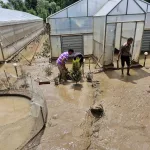WORLD TUBERCULOSIS DAY
Laboratories and laboratory networks are a fundamental component of tuberculosis (TB) control, providing testing for diagnosis, surveillance and treatment monitoring at every level of the health-care system. New initiatives and resources to strengthen laboratory capacity and implement rapid and new diagnostic tests for TB will require recognition that laboratories are systems that require quality standards, appropriate human resources, and attention to safety in addition to supplies and equipment. To prepare the laboratory networks for new diagnostics and expanded capacity, we need to focus efforts on strengthening quality management systems (QMS) through additional resources for external quality assessment programmes for microscopy, culture, drug susceptibility testing (DST) and molecular diagnostics. QMS should also promote development of accreditation programmes to ensure adherence to standards to improve both the quality and credibility of the laboratory system within TB programmes.
Corresponding attention must be given to addressing human resources at every level of the laboratory, with special consideration being given to new programmes for laboratory management and leadership skills. Strengthening laboratory networks will also involve setting up partnerships between TB programmes and those seeking to control other diseases in order to pool resources and to promote advocacy for quality standards, to develop strategies to integrate laboratories’ functions and to extend control programme activities to the private sector. Improving the laboratory system will assure that increased resources, in the form of supplies, equipment and facilities, will be invested in networks that are capable of providing effective testing to meet the goals of the Global Plan to Stop TB.
The laboratory has always played a critical role in diagnosing tuberculosis (TB) and monitoring its treatment. In the new millennium, the strength of the laboratory network is often a direct reflection of the success of TB control programmes. Developed countries have taken advantage of new technologies that provide rapid detection, identification and drug susceptibility testing of Mycobacterium tuberculosis, hastening the decline of the prevalence of the disease1–3 when combined with good treatment programmes. In contrast, many developing countries are burdened with high rates of TB and struggle to provide good-quality microscopy, with access to culture and drug susceptibility testing (DST) being scarce to non-existent.
For a long time, countries have demonstrated effective TB control using microscopy-based diagnosis and monitoring combined with well-managed treatment programmes. However, inadequate management and support of TB programmes and the laboratory networks are hindering progress against the disease. Also, the complications stemming from the HIV epidemic and multidrug-resistant TB (MDR-TB), especially in Africa and eastern Europe, prevent effective TB control that relies entirely on microscopy-based case detection and management. Effective control involves access to laboratory services at every level, which requires managing and supporting laboratory networks that provide reliable and consistent decentralized services. Although laboratory strengthening is beginning to gain higher priority on the TB agenda, as reflected in the new Stop TB Strategy, more efforts are needed to improve access to and utilization of existing diagnostics as well as to develop and implement new technologies.
Modern techniques such as fluorescence microscopy (FM), use of liquid cultures for isolation and DST, and amplification for detection of and/or for study of drug resistance are expensive, labour-intensive or relatively slow. Increased interest has therefore emerged in developing new diagnostics and in efforts to introduce modern diagnostic methods in developing countries. The Foundation for Innovative New Diagnostics (FIND) is now applying a systematic approach to research and development for new diagnostics. Focusing solely on finance, techniques and new diagnostics, however, often ignores the need for well-trained staff, quality management systems and other prerequisites that underpin the standards of practice in developed countries.
For countries where TB laboratory services are integrated with general laboratory services or where there is a large private sector, there is also a question of whether national tuberculosis programmes can successfully improve the quality of and access to laboratory services in the absence of combined efforts by all health programmes to support a general initiative of laboratory capacity-building.
Past efforts to provide a separate and parallel system of TB microscopy practices, records and monitoring may be insufficient to meet the demands of improving TB laboratory services in the context of changing health systems. There is growing recognition that the quality of TB laboratory networks serves as either the catalyst or rate-limiting step for further progress in TB control. This paper outlines some of the key technical and organizational challenges associated with microscopy, culture, DST and the corresponding safety issues. The different components of successful laboratory services will also be examined, concentrating on human resources, research, quality management systems and laboratory network structure.
Microscopy
Microscopy remains the mainstay of rapid TB case detection, especially for those patients who are most infectious to others, with the bacterial load involved often reflecting the extent of disease requiring immediate treatment. In most countries, especially those with the highest burden of TB, the direct Ziehl–Neelsen (ZN) smear is still the most common test. However, its sensitivity depends on the diligence of the technician and on use of the appropriate technique. The co-epidemics of HIV infection and TB, especially in Africa, and concerns that the ZN smear has lower sensitivity in those with HIV infection, have stimulated interest in practical methods to improve microscopy. Industrialized countries often use concentrated smears and FM, a combination showing high yield also in low-income, HIV high-prevalence countries, but requiring greater resources.
Culture methods and drug sensitivity testing
The use of culture methods for TB diagnosis and of DST are standard practices in high- resource countries; however, many low-resource countries still struggle to provide culture methods for priority needs such as drug resistance surveillance (DRS), extrapulmonary and childhood TB, and MDR-TB. There is considerable debate about the feasibility and cost of providing culture for routine detection of TB cases in the high-prevalence setting, not to mention what is the most appropriate diagnostic algorithm to use. However, many high-burden countries have not even developed the basic capacity for accurate and reliable culture for DRS and diagnosis of MDR-TB, as shown by the lack of data on drug resistance in most of the high-burden countries.
Human resources
Management of microscopy networks and referral laboratories for culture and DST require highly skilled laboratory scientists, who are either in low supply or often unwilling to work in low-paid government jobs. For many countries the human resources crisis is limiting laboratory services at all levels. At the peripheral level, the shortage of laboratory technicians is forcing countries to train a new cadre of individuals with little or no formal education. For acid-fast bacilli (AFB) microscopy and HIV rapid tests, these individuals who have been trained “on the job” can perform as well as formally trained laboratory technicians, but the training programmes must be well thought out and supported at all levels, and need routine EQA to monitor performance. Laboratory management and network management are underestimated capacities that will require new mentoring and training activities in order to provide the next generation of leaders to implement new technologies and programmes.
Laboratory network structure
The challenge to developing effective laboratory networks must take into account the evolving structure of the health-care system. Most high-resource countries have large private health-care systems, including laboratories, which provide high-quality care and services. Although the quality of care correlates with resources, factors such as laboratory quality standards and regulations, mandatory reporting of cases of TB and other infectious diseases, and specific public initiatives to work with private providers have also been responsible for successful integration of disease control programmes with private health care. However, in many countries with a high burden of TB, there is a struggle to monitor and assure the quality of testing and reporting in the growing private laboratory sector. In such settings, the national TB programmes and national reference laboratories (NRLs) must develop strategies to enrol private laboratories in EQA programmes and require reporting and referral of TB cases. However, it is unlikely that these bodies alone will be able to secure both national legislation and the resources to establish programmes that only monitor TB testing in private laboratories. This will probably require efforts to establish partnerships with other health programmes to lobby for national laboratory standards and sufficient structure to implement regulations.
A key issue is the organization of the TB laboratory services in relation to the national TB programme and the general health services. The traditional model is to have the NRL located within the national programme. An advantage of this arrangement results from the close cooperation between the two, which assures that the laboratory activities are closely aligned with the needs of the programme and receive appropriate support. The disadvantage of having a “stand-alone” TB NRL versus a TB section in an NRL facility with integrated laboratory services is that it can result in a rather small national TB laboratory with limited staff and service support. Furthermore, the laboratory requirements may be so much higher than those of the general services or other programmes that integration will be difficult. Representatives from all sectors of the health-care system should look strategically at what is the best structure for expanding and improving laboratory services.
Laboratory safety
Safety is a continuing concern for laboratory staff at all levels who work with specimens and cultures containing M. tuberculosis. It is the responsibility of the NRL and the national TB programme to address such concerns through a combination of training and education to help promote risk assessment and safe practices, and also to support reasonable safety improvements with respect to equipment, supplies and facilities. Microscopy carries a low risk if direct smears are prepared carefully in well-ventilated areas.Rather than purchase biological safety cabinets that are difficult to maintain, microscopy centres should invest in simple cabinets or “fan boxes” that are relatively inexpensive and efficiently exhaust air without filters, provided that they have sufficient extraction power. When suitably installed, such cabinets can offer a level of protection that reassures technical staff.
Quality control systems
The quality of testing services for TB remains a major barrier for microscopy, culture, DST and newer NAAT methods. Many countries are still struggling to expand effective EQA to all microscopy centres, both public and private. Effective EQA is even more important in the presence of HIV infection, with concerns that many patients will have paucibacillary specimens requiring detection of only a few AFB to make the diagnosis of TB. In the meantime, EQA may be the most practical approach to immediately improve test sensitivity, while further evidence is being obtained on the appropriateness of methods such as FM and concentration techniques, and new diagnostics are tested. one critical difference in many developed countries is the presence of laboratory regulations or accreditation programmes. Until countries develop, implement and monitor laboratory standards by regulation, a minimum step is to develop an accreditation process for NRLs.
Research
TB laboratories also play a pivotal role in performing research, especially operational research that supports evidence-based decisions for guiding laboratory practice. Whenever possible, such research should be performed in the field in low-resource settings, where the conditions represent the situation in most countries with a high burden of TB. In contrast, research performed in academic centres that have human and material resources that differ from those in public-sector services in low-resource countries may not always provide reproducible results under programme conditions. Research carried out to improve diagnostic methods and techniques can be published in the literature and guide countries’ decisions about implementing changes in technology and procedures. Many NRLs have the interest in and the capacity to perform operational research, and can be encouraged to carry it out if provided with training in research methods and by developing partnerships with research-focused institutions such as universities. It is important, however, to ensure that the NRL and other institutions balance research activities with priority initiatives to monitor and support the laboratory network. Financial and other incentives that are only available for research activities lead to misplaced priorities and neglect of the daily support that laboratory networks provide for TB control.
Laboratories are not just technologies, equipment and buildings; they are people and systems that manage the processes and standards required to produce accurate and timely results. Successful implementation of new diagnostic tests will still require functional networks of laboratories with trained and motivated staff, quality management systems and safe working environments. The Global Plan to Stop TB calls for 800 new culture and DST facilities at an estimated cost of US$ 700 million to reach its 2015 targets. The Global Fund to Fight AIDS, Tuberculosis and Malaria can help with these costs; however, there will also have to be a corresponding requirement for attention and investment in people, organizations and systems to successfully expand services. Resources for commodities are increasing; nevertheless, currently neither funds nor efforts are directed towards addressing the human resources needed for EQA, guidance and processes to establish and enforce quality systems, practical and reasonable safety standards and steps to determine optimum organizational structures and requirements for TB laboratory services. A new focus on expanding and strengthening laboratory systems for quality-assured services, that is microscopy, culture methods and DST,molecular methods like Naat,LPA etc will help achieve the targets.
(Author is Microbiologist, Certified infection control Auditor, Kidney Hospital Srinagar. Email: [email protected])





